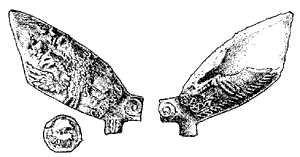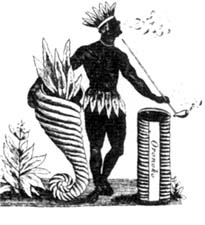No. 5/1991, p. 1-14
Gerhard Ermischer: A rich find of clay pipes from Aschaffenburg
During excavations at Aschaffenburg in the area of the old deanery
("Alte Dechantei"), the residence of the dean of the ecclesiastical
curia, a number of stone-built cellars, a latrine and a well were
found. The latrine turned out to have been dug specially for a two-day,
late-Baroque festival and was filled in immediately after it. Some
of the rubbish from the feast was thrown into the latrine. More
rubbish from the feast was found in the cellars; in cellar No. 3
a heap of rubbish contained 270 clay pipes.
These clay pipes are similar in shape, size and quality; they have
ovoid-type bowls all marked with the Gouda coat-of-arms on the left
of the heel. In addition, several different heel marks are represented:
the crowned "46", the "key", "BWB",
"46", and the "bundle of arrows" (on two bowls).
All these except the uncrowned "46" are well known Gouda
marks. Some of them are also known from other clay-pipe centres
in the Netherlands, Belgium, France, and particulary the Westerwald
area of Germany. The stems bear inscriptions containing the name
"GOUDA", although about 50 % read "GAUDA", the
German spelling. The facts that some pipes have a right side mark
"PM", which ist uncommon in the Netherlands, and that
some variations of the crowned "46" closely resemble those
from the Westerwald area suggest that the whole group of pipes are
Westerwald products with faked Gouda marks. The find has been dated
independently as 1740 or slightly later. Just at this time (1739-40),
a special law was passed in Gouda to protect the Gouda pipemakers;
only pipes made in Gouda were allowed to bear the Gouda coat-of-arms.
As can be seen, once the German pipemakers started to copy the Gouda
"trade mark" on their own products.
Pipe with heel showing egg-shaped bowl
and BWB heel mark, ?Holland,
between 1739 and c. 1750
|
|
|
|
No. 5/1991, p. 14 ff.
Rüdiger J.J. Articus: A clay pipe from 1866
Part of a clay pipe found in Harvestehude, Hamburg, shows a double-headed
eagle on the left of the bowl and a single eagle on the right. A
hand above the latter is trying to grasp the crown above the double-headed
eagle. With the help of the inscription "GERMA(NIA)E PAX"
on the pipe and by comparison with a similar fragment found near
Copenhagen, the design on the bowl is interpreted as depicting Prussia's
(single eagle) attempt to conquer Austria (double eagle). Thus the
pipe shows a political theme and was clearly manufactured after
the peace treaty between Prussia and Austria (1866), which marked
the end of the war between the two. The pipe was produced by Gerrit
and Jan Prince, Gouda.

Pipe with heel, bowl shows a crowned two-headed
eagle
and GERMA[NIA]E PAX, produced in Gouda to commemorate the
Treaty of Paris in 1866
|
|

|
No. 5/1991, p. 17 ff.
Martin Kügler: Political themes on pipe bowls - an example
from 1846
Pipe bowls shaped like heads of well known persons, often with a
political connection, are relatively common. However, very little
is known about the functional significance of smoking a pipe whose
design has a political connection. One clear example is provided
by a ban which in 1846 the government of the kingdom of Bavaria
put on pipes portraying the theologian Johann Czerski; here, the
functional significance of smoking a particular pipe is obvious
- in this case the smoker identified himself with the ideas of Czerski.
It ist not altogether impossible that the reason for smoking a pipe
portraying a certain person was opposition towards that person.
The reasons why "political pipes" were smoked as well
as the cultural and political atmosphere in which they were smoked
can only be reconstructed from detailed information on the pipes,
the persons portrayed and the historical background.
|

|
|

Pipe-clay figure of St Anthony found in the moat
of Lüdinghausen castle
|
No. 5/1991, p. 19-28
Bernd Thier: A pipe-clay figure from the late Middle Ages found
in Lüdinghausen
A small pipe-clay figure found in Lüdinghausen is interpreted
on the basis of characteristic features and associated objects as
a 15th or 16th century model of St. Anthony. A woodcut dating from
the late Middle Ages shows the veneration of St. Anthony, who is
receiving a gift of what is probably a similar small clay figure.
Such religious figures made of pipe clay are not uncommon. Comparable
figures of St. Anthony have been found in the Rhineland and the
Netherlands. However, they all differ in certain respects from this
figure, and although numerous places have been identified where
these figures were made, it is not yet possible to say with any
certainty where this particular figure was produced. It is interesting
to note that many of the production centres of these clay figures
are also known to have been (later) clay-pipe production centres.
It is suggested that this is no mere coincidence.
|
|
|
No. 5/1991, p. 28 f.
Rüdiger J.J. Articus: Smoking and tobacco-pipe manufacture
in Schleswig-Holstein - an amendment
Further to the information on clay-pipe manufacture in Itzehoe given
in KnasterKOPF No. 2/1990, p. 30-33,
it is now known that two clay-pipe makers were active there in 1837,
but their production appears to have been relatively modest.
|
|

